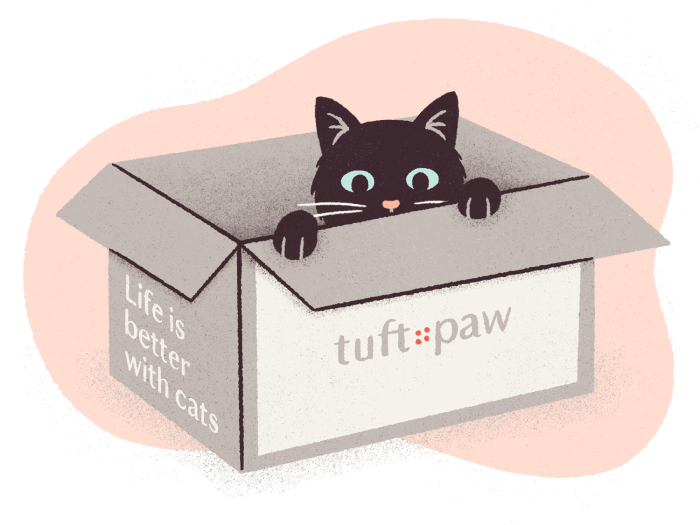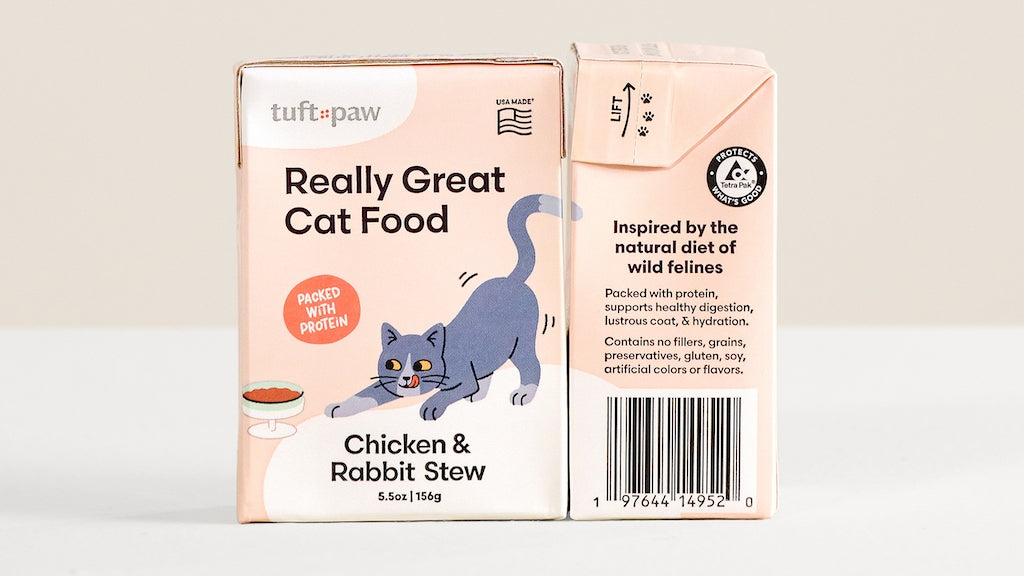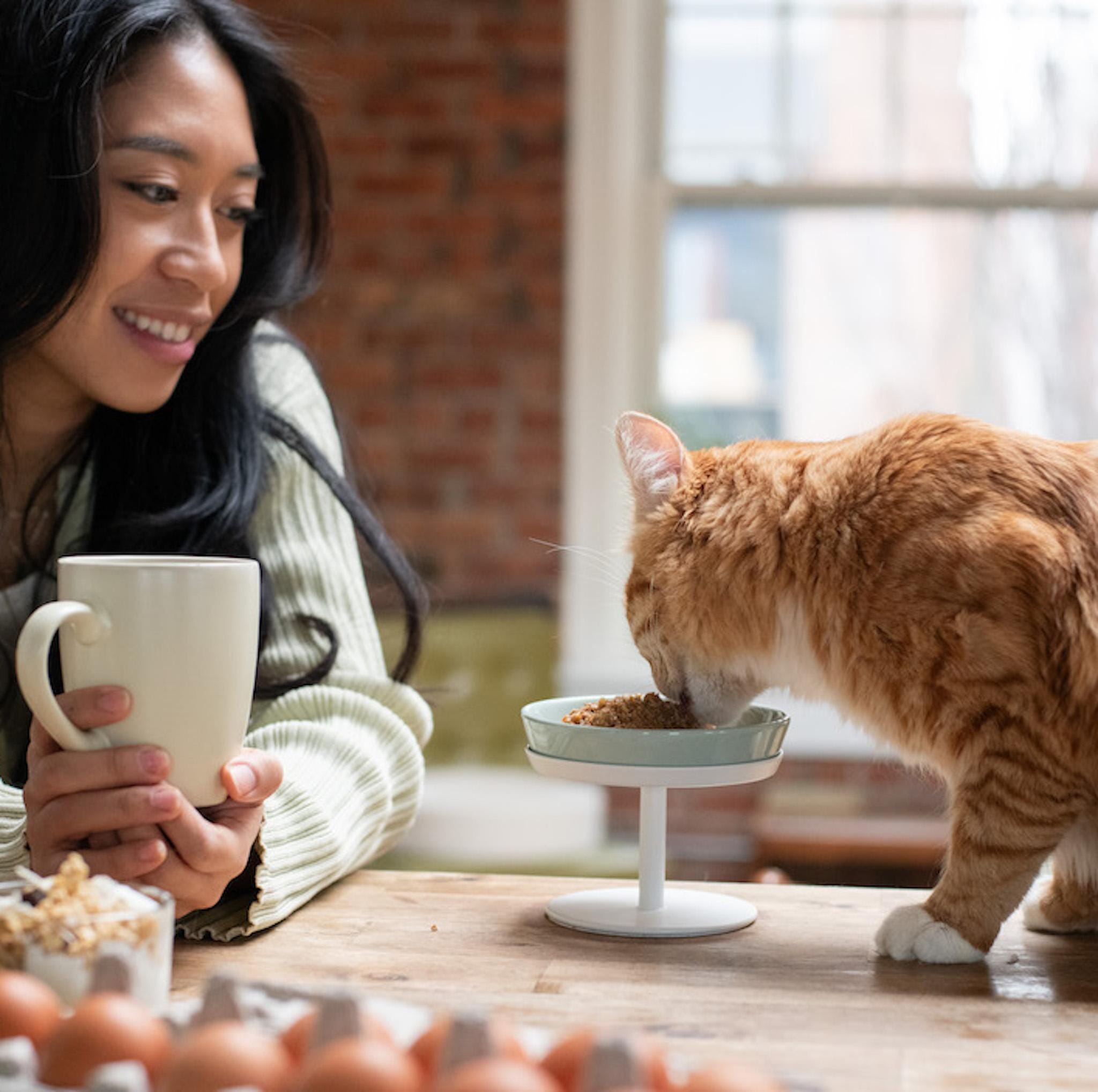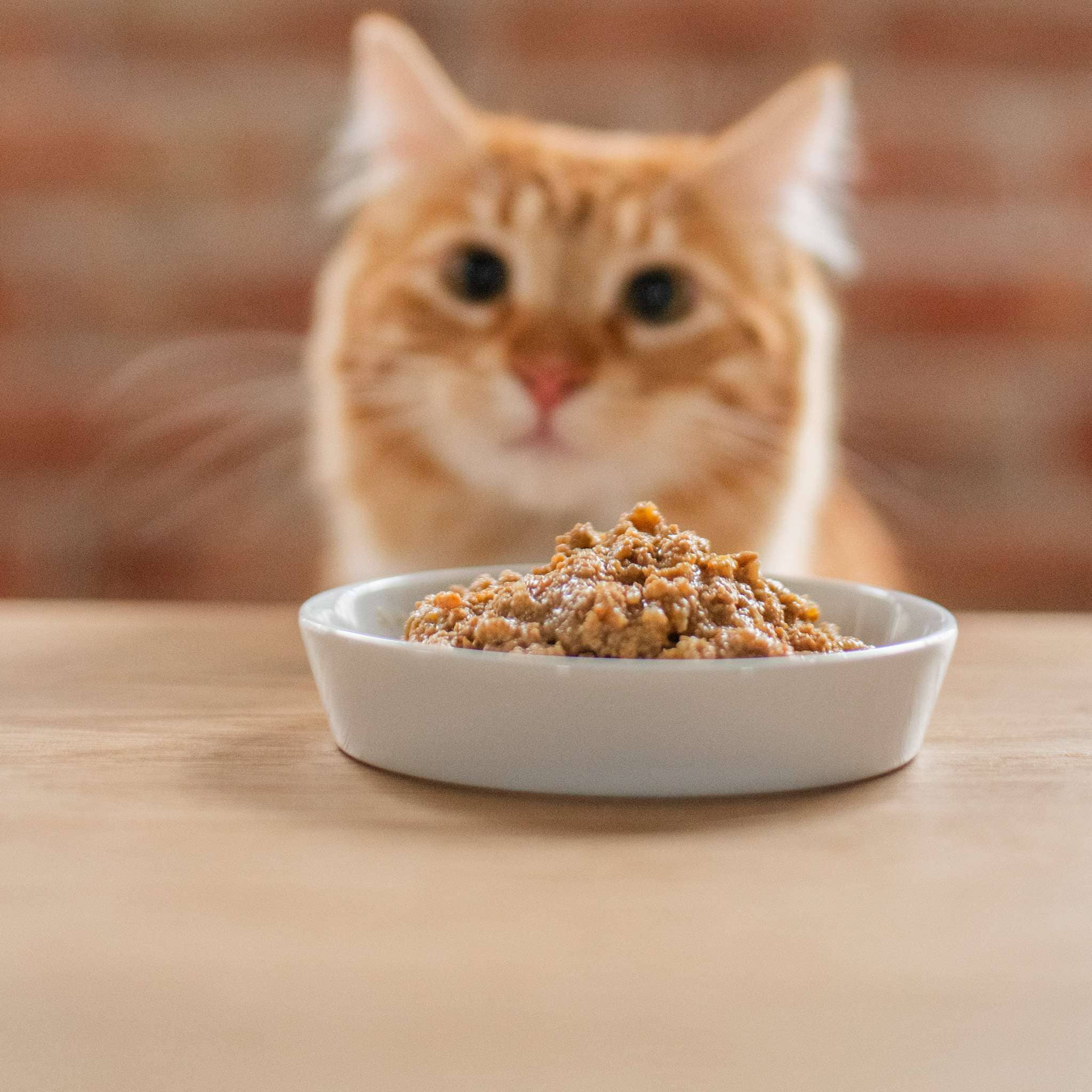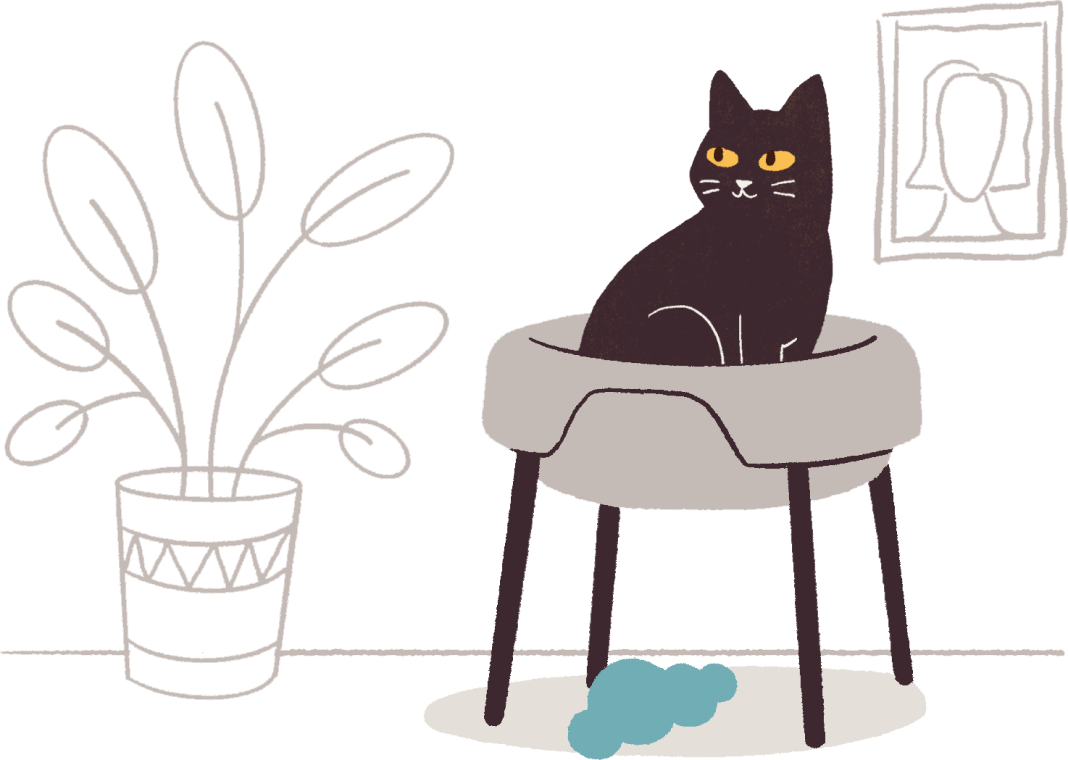Cats are carnivores, so to be happy and healthy they need a diet rich in high-quality animal protein. In this article, we’ll explore cats’ protein needs, tell you what to look for in cat food, and give you our picks for the best high protein cat foods on the market today?
Here at tuft + paw, we are cat experts. We're intimately familiar with the cat food features that are most important to cats and cat parents alike. This list is based on consultation with a feline nutritionist, veterinarian, hundreds of online reviews, and our own experience as cat parents.
Tip: For more specific food recommendations, see our lists of the best kitten foods and the best cat foods for sensitive stomachs.
Cheat Sheet: The Best High Protein Cat Foods
1) tuft + paw Really Great Cat Food
| Pros | high quality animal protein, first 2 ingredients are chicken-based, low carbohydrates, no fillers, dietary fiber to aid digestion, salmon oil for omega-3s, affordable price point, high moisture content, human-grade ingredients |
| Cons | not available in pet stores |
| Calories | 138 cal/5.5 oz box = 25 cal/oz |
| Price | $69 for 24 x 5.5 oz box = $0.52/oz |
2) RAWZ Shredded Chicken and Duck Cat Food
| Pros | high quality animal protein, first 3 ingredients are poultry-based, high moisture content, fish oil for omega-3s, human-grade ingredients |
| Cons | contains tapioca starch and sunflower oil, unsuitable for kittens, not available at major retailers |
| Calories | 136 cal/5.5-oz can = 25 cal/oz |
| Price | $78.99 for 24 x 5.5 oz cans = $0.60/oz |
3) Smalls Ground Cow Cat Food
| Pros | high quality animal protein, first 2 ingredients are beef-based, low carbohydrates, human-grade ingredients, cod liver oil for omega-3s, very high caloric density, convenient subscription service |
| Cons | expensive, not available in pet stores, contains canola oil, food ships frozen |
| Calories | 200 cal/4.1 oz pack = 40 cal/oz |
| Price | $4.00 per 4.1 oz pack = $0.97/oz |
4) Merrick Backcountry Grain Free Real Turkey Recipe Paté
| Pros | high quality animal protein, first four ingredients are poultry-based, low carbohydrates, salmon oil for omega-3s, good moisture content, affordable price point |
| Cons | contains plant proteins and gums |
| Calories | 202 cal/5-oz can = 40 cal/oz |
| Price | $62.16 for 24 x 5-oz cans = $0.52/oz |
5) Blue Buffalo Wilderness Wild Delights Chicken & Salmon
| Pros | high quality animal protein, first ingredients are animal-based, salmon for omega-3s, good moisture content, moderate price point |
| Cons | contains potato starch and guar gum, unsuitable for kittens |
| Calories | 81 cal/3-oz can = 27 cal/oz |
| Price | $47.76 for 24 x 3-oz cans = $0.66/oz |
6) Wellness Core Tiny Tasters Tuna & Shrimp
| Pros | high quality animal protein, tuna for omega-3s, very high moisture content, convenient packaging |
| Cons | expensive, contains tapioca starch, sunflower oil, and guar gum, small portion sizes, unsuitable for kittens |
| Calories | 43 cal/1.75-oz can = 25 cal/oz |
| Price | $17.88 for 12 x 1.75-oz pouches = $0.85/oz |
What Is High Protein Cat Food?
Cats are obligate carnivores, meaning they must get most of their nutrition from animal tissue. To meet this need, all commercial cat food is high in protein when compared to dog food or human food. However, not all cat foods are created equal–some are higher in protein than others.
To be considered a high protein cat food and qualify for this list, a cat food must be at least 50% protein on a dry matter basis. The best cat foods have a macronutrient balance of high protein, moderate fat, and low carbohydrates.
 Really Great Cat Food & Dock Bowl and Stand by tuft + paw
Really Great Cat Food & Dock Bowl and Stand by tuft + paw
Guaranteed Analysis vs Dry Matter
Two terms you’ll often see when comparing wet cat foods are “guaranteed analysis” and “dry matter”. Here’s what they mean:
Guaranteed Analysis (GA) in Cat Food
Guaranteed analysis refers to the minimum/maximum percentage of certain nutrients that will be found in a can of a given cat food, including water content. This may be accompanied by the term “as fed”, meaning the food as-is, or as-fed to your cat, will adhere to these guaranteed nutrient percentages.
For example, a cat food label that says it has “8% protein (min)” will have no less than 8% protein by weight straight out of the can. A given can of this food may have more than 8% protein.
Guaranteed analysis is useful for understanding the nutrient composition of a specific cat food, but it’s not useful for comparing different cat foods. This is because different cat foods have different water content, which changes the nutrient percentages shown in the guaranteed analysis. To truly compare different foods, you need to exclude water and compare nutrition on a dry matter basis.
Dry Matter in Cat Food
“Dry matter” refers to the amount of certain nutrients found in a can of given cat food excluding water. Some brands provide dry matter nutrient breakdowns based on their average can of food (sometimes called “typical analysis”). When these numbers are not available, you can calculate the dry matter percentages using the guaranteed analysis.
Comparing cat foods based solely on the as-fed guaranteed analysis can be misleading. The moisture content in a diet dilutes the concentration of other nutrients, making it essential to evaluate foods on a dry matter basis for accurate comparisons.
How to Calculate Dry Matter from Guaranteed Analysis
Here’s an example of how guaranteed analysis can be misleading. At first glance, Food 2 seems to have more crude protein than Food 1...
|
Food 1 |
Food 2 |
|
|
Food 1 is 82% water, so we know that solid ingredients make up the remaining 18%. Crude protein makes up 10 of those 18 percentage points, so we can calculate protein on a dry matter basis like this: 10/18 = 0.556 = 55.6% crude protein.
Food 2 is 72% water, so solid ingredients make up the remaining 28%. Crude protein accounts for 13 of those 28 percentage points, so we can calculate protein on a dry matter basis like this: 13/28 = 0.464 = 46.4% crude protein.
As you can see, Food 2 looks like it has more protein from the guaranteed analysis (13% vs 10%), but when we remove water and only consider the solid ingredients of the food it actually has less protein (46.4% vs 55.6%).
 Really Great Cat Food & Dock Bowl and Stand by tuft + paw
Really Great Cat Food & Dock Bowl and Stand by tuft + paw
What to Look for in a High Protein Cat Food
High Quality Animal Protein
The cornerstone of a high protein cat food is—you guessed it—high quality animal protein. A high protein cat food should have 50% crude protein or more on a dry matter basis. Cats have a unique metabolism suited to creating energy from proteins and fats, unlike us humans who primarily use carbohydrates for energy. This is why animal tissues are so important to cats: they're concentrated sources of protein and fat with negligible carbohydrates. Without enough protein and fat to provide energy, cats will begin breaking down their own muscle tissues and organs for energy!
Look for foods which have clearly-named, easily digestible animal meats as the first ingredients (e.g. chicken, salmon, turkey liver). Avoid foods that rely on animal byproducts, animal meals, or plant proteins for their protein content, as these can contain less digestible components.
Healthy Animal Fats
In addition to protein, healthy animal fats play a vital role in your cat's diet. The best cat foods get fat from animal sources rather than plant oils. It’s also great to have a rich source of omega-3 fatty acids like salmon meat or cod liver oil, which reduce inflammation and contribute to a lustrous coat.
Low Carbohydrates
Cats have no natural requirement for carbohydrates, and a high protein cat food should reflect this. In the wild, cats eat minimal carbs (i.e. just what’s in their prey’s stomach), and replicating this at home supports their nutritional needs. The feline digestive system is much better suited for digesting and absorbing nutrients from protein sources than carbs.
Tip: Check out our list of the best low carb cat foods and best grain-free cat foods (yes those are different things!)
 Really Great Cat Food & Dock Bowl and Stand by tuft + paw
Really Great Cat Food & Dock Bowl and Stand by tuft + paw
Sufficient Moisture Content
Maintaining proper hydration is paramount for your cat's health. Cats have a low thirst drive so feeding them a high moisture food goes a long way in keeping them hydrated. Moisture also facilitates digestion and can help prevent other health complications like urinary stones.
Meets AAFCO Nutritional Standards & Life Stage Requirements
When selecting cat food, always check if it meets the nutritional standards set by the Association of American Feed Control Officials (AAFCO). This ensures that the food is formulated to provide a complete and balanced diet for your cat. AAFCO compliance is a crucial indicator of the food's quality and suitability for your cat's overall health.
Additionally, check the AAFCO statement on the label to ensure it’s appropriate for your cat's specific life stage. A cat’s different life stages have different nutritional requirements. For example, kittens need more calories than adult cats to support their rapid growth, while senior cats benefit from diets that maintain muscle mass.
Here are the key AAFCO terms you’ll see on a label:
- Complete and Balanced – “Complete” means the product contains all the nutrients required. “Balanced” means the nutrients are present in the correct ratios.
- “Growth” life stage – Early life stage when kittens have greater nutritional needs to fuel their growth and development.
- “Maintenance” life stage – Adult cats who are no longer growing only require nutrition for maintenance of a healthy body weight.
- “Gestation/lactation” life stage – Pregnant/mother cats who need to feed their kittens have greater nutritional needs than non-pregnant, non-lactating adult cats.
- All life stages – This means the food is appropriate for both kittens and adult cats, though feeding directions will vary depending on your cat’s life stage. These foods can help take the guesswork out of switching from kitten to adult cat food.
Our Criteria for Choosing the Best High Protein Cat Food
- High protein content – Every food on this list contains a minimum of 50% protein on a dry matter basis.
- Meets AAFCO Standards – All foods on this list are formulated to meet the AAFCO Cat Food Nutrient Profiles for either adult cats or all life stages.
- High quality animal protein – All foods on this list prioritize animal proteins as their first ingredients rather than animal byproducts.
- Healthy fats – Quality cat food should contain healthy fats from animal sources, such as meat or fish oil.
- Moisture content – High moisture content in food helps cats avoid the health problems associated with dehydration.
- Carbs & plant-based content – Cats are obligate carnivores who should be eating primarily animal protein, so we prefer foods with low carbohydrate content and low plant material content.
- Price
Deep Dive: The Best High Protein Cat Foods
1) tuft + paw Really Great Cat Food
Price: $69 for 24 x 5.5 oz box = $0.52/oz
Calories: 138 cal/5.5 oz box = 25 cal/oz
Life Stage: all life stages
Disclaimer: Yes, we included our own cat food here. This is because we truly think it performs excellently compared to other cat foods on the market. We subjected it to the same scrutiny as every other food on this list and asked for honest opinions from experts and cat parents.
Our pick for the best high protein cat food is tuft + paw’s Really Great Cat Food. This formula prioritizes easily digestible animal protein with chicken as the primary meat source, and rabbit as a secondary source. Together these two meat sources provide essential amino acids and fatty acids, particularly taurine and arachidonic acid which are both especially vital to cats. The salmon oil provides a boost of omega-3s to aid immune function, reduce inflammation, and assist in brain and eye health. There are no filler carbs (e.g. starches, flours, potatoes), and each plant-based ingredient is there to provide either specific vitamins, minerals, antioxidants, or dietary fiber. The high moisture content and lack of gums facilitate digestion and keep things running smoothly in the GI tract. Cat parents will also appreciate the convenient subscription service and affordable price tag of $0.52/oz.
|
Ingredients: chicken, chicken broth, pumpkin puree, rabbit, carrots, ground golden flaxseed, natural flavor, tricalcium phosphate, agar-agar, salmon oil, dandelion greens, potassium chloride, vitamins , magnesium amino acid chelate, choline chloride, taurine, minerals , sea salt. |
|
Guaranteed Analysis
|
Dry Matter Analysis
|
| Pros | Cons |
|
|
2) RAWZ Shredded Chicken and Duck Cat Food
 Credit: RAWZ
Credit: RAWZ
Price: $78.99 for 24 x 5.5 oz cans = $0.60/oz
Calories: 136 cal/5.5-oz can = 25 cal/oz
Life Stage: adult maintenance
Our runner-up for the best high protein cat food is RAWZ Shredded Chicken and Duck Wet Cat Food. RAWZ prioritizes easily digestible animal protein in all their recipes, and this one comes in at 61% crude protein on a dry matter basis. The first three ingredients are chicken, chicken broth, and duck. It’s also a good choice for indoor adult cats with its moderate caloric density and low fat recipe. We also like the inclusion of fish oil for an added dose of omega-3 fatty acids.
Our main gripe is the inclusion of tapioca starch and sunflower oil, which are likely added for texture. These plant-based ingredients are not nutritionally necessary for cats. A minor inconvenience is that RAWZ is not available at major online retailers and big box stores, but you can probably find it at your local independent pet store.
|
Ingredients: Chicken, Chicken Broth, Duck, Tapioca Starch, Sunflower Oil, Minerals (Magnesium Amino Acid Chelate, Zinc Amino Acid Chelate, Iron Amino Acid Chelate, Manganese Amino Acid Chelate, Copper Amino Acid Chelate, Calcium Iodate, Sodium Selenite), Calcium Chloride, Fish Oil, Vitamins (Ascorbic Acid (source of Vitamin C), Thiamine Mononitrate, Vitamin E Supplement, Niacin Supplement, Vitamin A Supplement, d-Calcium Pantothenate, Riboflavin, Pyridoxine Hydrochloride, Folic Acid, Biotin, Vitamin B12 Supplement, Vitamin D3 Supplement), Tricalcium Phosphate, Parsley, Choline Chloride, Salt, Taurine, Potassium Chloride. |
|
Guaranteed Analysis
|
Dry Matter Analysis
|
| Pros | Cons |
|
|
3) Smalls Ground Cow Cat Food
 Credit: Smalls
Credit: Smalls
Price: $4.00 per 4.1 oz pack = $0.97/oz
Calories: 200 cal/4.1 oz pack = 49 cal/oz
Life Stage: all life stages
Smalls is known for their high quality cat food, and their Ground Cow recipe is one of the highest protein options. Excluding water, this food is 55% crude protein and 35% fat, so it packs a serious nutritional punch. The first two ingredients are beef and beef liver, which can be a good option for cats who don’t like the usual bird- or fish-based foods. Liver is also an excellent source of bioavailable vitamin A, which is important because cats lack the enzyme needed to convert beta-carotene (common plant source of vitamin A) into vitamin A. The dietary fiber comes from vegetables like green beans and spinach, which we certainly prefer to filler starches. We also appreciate the cod liver oil for the omega-3s.
The main drawback is that Smalls is the most expensive food on our list ($0.97/oz). It’s also super calorically dense (49 cal/oz), so it may not be ideal for chubby indoor cats (no judgment though!). This recipe also contains a small amount of canola oil, but it’s a ways down the ingredients list. There’s also the small inconveniences of it only being available on Smalls’ website and shipping frozen. All Smalls foods need to be thawed before feeding to your cat.
|
Ingredients: Beef, beef liver, green beans, spinach, water sufficient for processing, dried yeast, tricalcium phosphate, canola oil, potassium chloride, salt, magnesium proteinate, choline chloride, taurine, dandelion greens, dried kelp, zinc proteinate, iron proteinate, cod liver oil, niacin supplement, vitamin E supplement, copper proteinate, vitamin A supplement, manganese proteinate, thiamine mononitrate, d-calcium pantothenate, pyridoxine hydrochloride, vitamin D3 supplement, riboflavin supplement, vitamin B12 supplement, folic acid, sodium selenite, biotin. |
|
Guaranteed Analysis
|
Dry Matter Analysis
|
| Pros | Cons |
|
|
4) Merrick Backcountry Grain Free Real Turkey Recipe Paté
 Credit: Merrick Pet Care
Credit: Merrick Pet Care
Price: $62.16 for 24 x 5-oz cans = $0.52/oz
Calories: 202 cal/5-oz can = 40 cal/oz
Life Stage: all life stages
Merrick Backcountry Turkey Paté is a great high protein option for cats that comes at an affordable price. The first four ingredients are all from turkey or chicken, which contribute to the 54% protein content (excluding water). Whole flaxseed serves as a source of dietary fiber and ALA (an omega-3 fatty acid), while salmon oil is a rich source of other omega-3s like DHA. Merrick also has plenty of other formulas if your cat doesn’t like turkey.
Unfortunately, there are a few filler ingredients in this food. It includes potato protein and pea protein, which are less digestible for cats than animal protein. There are also three different gums: guar, locust bean, and xanthan. These are thickeners which help the texture of the food but are not nutritionally necessary.
|
Ingredients: Deboned Turkey, Turkey Broth, Deboned Chicken, Chicken Liver, Potato Protein, Pea Protein, Natural Flavor, Dried Egg Product, Calcium Carbonate, Sodium Phosphate, Guar Gum, Potassium Chloride, Salt, Choline Chloride, Salmon Oil, Agar-Agar, Flaxseed, Locust Bean Gum, Xanthan Gum, Taurine, Minerals (Zinc Amino Acid Complex, Iron Amino Acid Complex, Manganese Amino Acid Complex, Copper Amino Acid Complex, Potassium Iodate, Cobalt Glucoheptonate, Sodium Selenite), Vitamins (Vitamin E Supplement, Vitamin B12 Supplement, d-Calcium Pantothenate, Vitamin A Supplement, Niacin, Vitamin D3 Supplement, Riboflavin Supplement, Folic Acid, Pyridoxine Hydrochloride, Biotin, Thiamine Mononitrate). |
|
Guaranteed Analysis
|
Dry Matter Analysis
|
| Pros | Cons |
|
|
5) Blue Buffalo Wilderness Wild Delights Chicken & Salmon
 Credit: Chewy
Credit: Chewy
Price: $47.76 for 24 x 3-oz cans = $0.66/oz
Calories: 81 cal/3-oz can = 27 cal/oz
Life Stage: adult maintenance
For cats who like a mix of chicken and salmon in their diet, this formula from Blue Buffalo is sure to please. At 50% crude protein and 22% fat (dry matter), it qualifies as a high protein, moderate fat option. The inclusion of salmon provides omega-3s as well as an additional source of animal protein. We appreciate the high water content of 82%, which can help prevent dehydration in cats. Cat parents with heftier cats will also like the lower caloric density at 27 cal/oz. Our only complaint with this food is the inclusion of two filler carbs: potato starch and guar gum. These ingredients are not nutritionally necessary, but may help with texture. This food is a good option for most cats, though it doesn’t excel in any one area.
|
Ingredients: Chicken, Chicken Broth, Water, Salmon, Chicken Liver, Dried Egg Product, Potato Starch, Natural Flavor, Guar Gum, Sodium Phosphate, Calcium Carbonate, Potassium Chloride, Taurine, Salt, Choline Chloride, Iron Amino Acid Chelate, Zinc Amino Acid Chelate, Vitamin E Supplement, Thiamine Mononitrate (Vitamin B1), Copper Amino Acid Chelate, Manganese Amino Acid Chelate, Sodium Selenite, Niacin Supplement (Vitamin B3), Calcium Pantothenate (Vitamin B5), Pyridoxine Hydrochloride (Vitamin B6), Riboflavin Supplement (Vitamin B2), Vitamin A Supplement, Biotin (Vitamin B7), Potassium Iodide, Vitamin D3 Supplement, Vitamin B12 Supplement, Folic Acid (Vitamin B9). |
|
Guaranteed Analysis
|
Dry Matter Analysis
|
| Pros | Cons |
|
|
6) Wellness Core Tiny Tasters Tuna & Shrimp
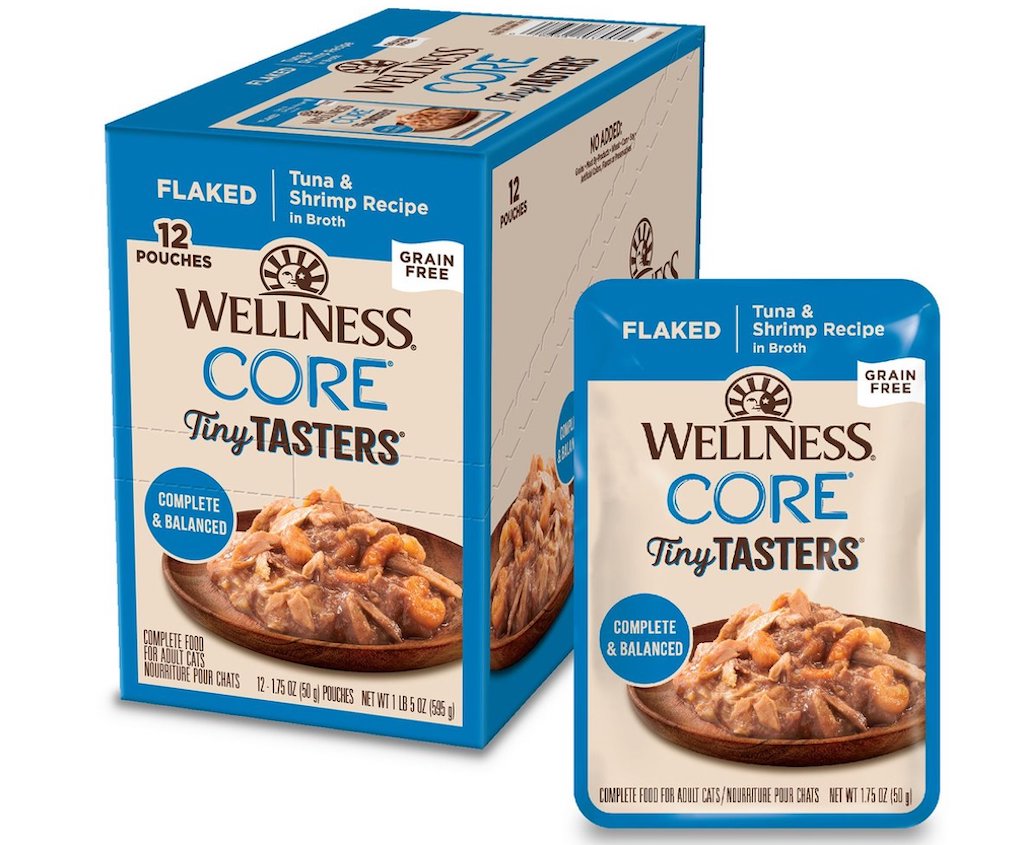 Credit: Chewy
Credit: Chewy
Price: $17.88 for 12 x 1.75-oz pouches = $0.85/oz
Calories: 43 cal/1.75-oz can = 25 cal/oz
Life Stage: adult maintenance
Wellness CORE’s Tiny Tasters are something a little different from the usual canned paté. This food comes in convenient 1.75-oz pouches, which are the perfect portion for a small meal. This tuna and shrimp recipe is exceptionally high in protein—85% when calculated on a dry matter basis. It’s also very high in water, so your cat will be getting a good dose of hydration along with their protein. The tuna and mackerel provide essential omega-3s, and there are plenty of other formula options if your cat’s not a seafood lover.
The main drawback with this formula is it could get a little pricey as your primary food ($0.85/oz) and the portions are quite small. You’d probably need to use two packs per meal for a large cat. It also has tapioca starch, sunflower oil, and guar gum, all of which are plant-based ingredients that are not nutritionally necessary. Finally, as an adult maintenance food, this recipe is not suitable for kittens.
|
Ingredients: Tuna, Tuna Broth, Water Sufficient for Processing, Mackerel, Shrimp, Tapioca Starch, Sunflower Oil, Natural Flavors, Guar Gum, Tricalcium Phosphate, Taurine, Magnesium Sulfate, Vitamins (Vitamin E Supplement, Thiamine Mononitrate, Niacin, Vitamin A Supplement, Pyridoxine Hydrochloride, d-Calcium Pantothenate, Riboflavin Supplement, Folic Acid, Vitamin D3 Supplement, Biotin, Vitamin B12 Supplement), Potassium Chloride, Choline Chloride, Minerals (Zinc Amino Acid Chelate, Iron Amino Acid Chelate, Menadione Sodium Bisulfite Complex, Manganese Amino Acid Chelate, Copper Amino Acid Chelate, Potassium Iodide). |
|
Guaranteed Analysis
|
Dry Matter Analysis
|
| Pros | Cons |
|
|
High Protein Cat Food FAQs
How much protein should be in my cat's diet?
Cats generally thrive on diets with at least 50% protein on a dry matter basis. This ensures they receive the essential amino acids crucial for their overall health and well-being.
Are plant-based proteins suitable for cats?
Cats are obligate carnivores, and their nutritional needs are best met with animal-based proteins. While plant proteins can be included, on their own they won’t provide all the essential amino acids that cats require.
Can I trust the guaranteed analysis on cat food labels?
While guaranteed analysis provides valuable information, it's essential to factor in the moisture content when comparing foods. Comparing cat foods on a dry matter basis offers a more accurate representation of nutrient concentrations.
How do I transition my cat to a high protein diet?
Gradual transitions are key. Mix small amounts of the new high protein food with the current one, slowly increasing the proportion over ten days to avoid digestive issues.
Do indoor cats need a high protein diet?
Indoor cats don’t have any special need for a high protein diet—it’s good for them just like it’s good for all cats. What indoor cats do benefit from is a bit of extra dietary fiber and low caloric density to prevent obesity. See our list of the best indoor cat foods for some recommendations.
Conclusion
When shopping for a high protein cat food, look for at least 50% crude protein on a dry matter basis, as well as all the other usual criteria: quality ingredients, low carbs, good moisture content, etc. Our favorite high protein cat foods are tuft + paw’s Really Great Cat Food and RAWZ Shredded Chicken and Duck, with their appetizing protein sources and high quality ingredients. Depending on what your cat likes, other good options could be Smalls Ground Cow, Merrick Backcountry Turkey Paté, and Blue Buffalo Wilderness Wild Delights Chicken & Salmon. Each of these formulas offers tons of animal protein. For cats with a taste for seafood, you could try Wellness CORE’s Tiny Tasters Tuna & Shrimp. Remember to take it slow when transitioning your cat to their new food, and you should be just fine. Good luck!
